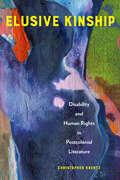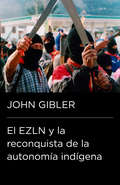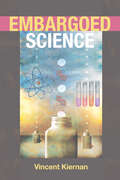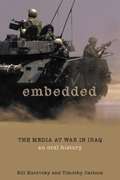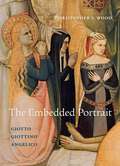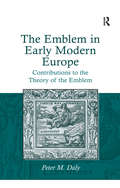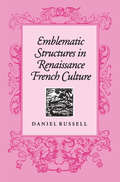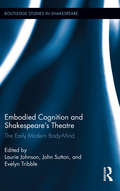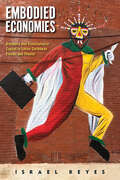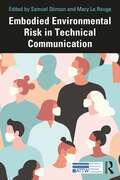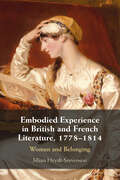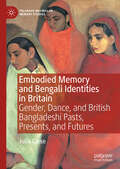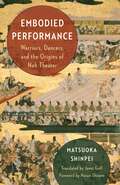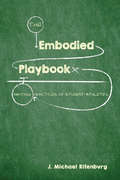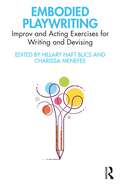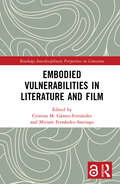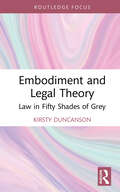- Table View
- List View
Elusive Kinship: Disability and Human Rights in Postcolonial Literature
by Christopher KrentzCharacters with disabilities are often overlooked in fiction, but many occupy central places in literature by celebrated authors like Chinua Achebe, Salman Rushdie, J. M. Coetzee, Anita Desai, Jhumpa Lahiri, Edwidge Danticat, and others. These authors deploy disability to do important cultural work, writes Christopher Krentz in his innovative study, Elusive Kinship. Such representations not only relate to the millions of disabled people in the global South, but also make more vivid such issues as the effects of colonialism, global capitalism, racism and sexism, war, and environmental disaster. Krentz is the first to put the fields of postcolonial studies, studies of human rights and literature, and literary disability in conversation with each other in a book-length study. He enhances our appreciation of key texts of Anglophone postcolonial literature of the global South, including Things Fall Apart and Midnight’s Children. In addition, he uncovers the myriad ways fiction gains energy, vitality, and metaphoric force from characters with extraordinary bodies or minds. Depicting injustices faced by characters with disabilities is vital to raising awareness and achieving human rights. Elusive Kinship nudges us toward a fuller understanding of disability worldwide.
Elwood's Bath
by Larry Dane BrimnerYoung Elwood prepares for bathtime as he adds his favorite playmates, including eight large elephants, to the water.
ELZN y la renconquista de la autonomía indígena
by John GiblerUna voz se alzó aquel 1° de enero de 1994: era el llamado de justicia de un pueblo oprimido desde hace siglos. Una voz se alzó aquel 1° de enero de 1994: era el llamado de justicia de un pueblo oprimido desde hace siglos. El Ejército Zapatista de Liberación Nacional (EZLN) se rebeló contra el "primer mundo" y contra la historia; tomó "el hambre de los indígenas, el aura de carencia y las esgrimió como arma". A casi veinte años del levantamiento, el zapatismo aún busca reconquistar la autonomía de los pueblos indígenas a partir de una ideología anticolonialista, antinacionalista y anticapitalista: "Autonomía no significa aislamiento; significa sustentabilidad sin imposiciones externas: soberanía social, política y cultural". El camino no ha sido fácil, pues el movimiento se ha enfrentado a grupos paramilitares y otras fuerzas armadas impuestas por el opresivo aparato de Estado. Esta crónica es el resultado de muchos años de convivencia del periodista John Gibler con la comunidad zapatista. Con una mirada incisiva aborda el incansable espíritu de rebelión y resistencia frente al poder gubernamental en México.
Emancipation and Illusion: Rationality and Gender in Habermas's Theory of Modernity
by Marie FlemingIn this comprehensive analysis of Jürgen Habermas's philosophy and social theory, Marie Fleming takes strong issue with Habermas over his understanding of rationality and the lifeworld, emancipation, history, and gender. Throughout the book she focuses attention on the various ways in which an idea of emancipation motivates and shapes his universalist theory and how it persists over several major changes in methodology. Her critique of Habermas begins from the view that universalism has to include a vision of gender equality, and she asks why Habermas, despite deeply held concerns about equality and inclusiveness, repeatedly and systematically relegates matters of gender to secondary status in his social and moral theory. She extends her critique to a range of issues in his theory of rationality and examines what she views as his very problematical claims about truthfulness, art, and bourgeois intimacy.The point of Fleming's critique of Habermas is not to dispute universalism, but to build on the key universalist principles of inclusiveness and equality. She is not persuaded by the view, shared by both sympathizers of Habermas and his postmodern critics, that to be for or against Habermas is to be for or against universalism. Her intention rather is to show that Habermas's theory of modernity is so structured that it cannot achieve its universalist aims. Contending that his theory is not universalist enough, she claims that universalism has to be reconceived as a radical, critical, and historical project.
Embargoed Science
by Vincent KiernanThe popular notion of a lone scientist privately toiling long hours in a laboratory, striking upon a great discovery, and announcing it to the world is a romanticized fiction. Vincent Kiernan's Embargoed Science reveals the true process behind science news: an elite few scholarly journals control press coverage through a mechanism known as an embargo. The journals distribute advance copies of their articles to hundreds and sometimes thousands of journalists around the world, on the condition that journalists agree not to report their stories until a common time, several days later. When the embargo lifts, airwaves and newspaper pages are flooded with stories based on the journal's latest issue. In addition to divulging the realities behind this collusive practice, Kiernan offers an unprecedented exploration of the embargo's impact on public and academic knowledge of science and medical issues. He surveys twenty five daily U.S. newspapers and relates his in-depth interviews with reporters to examine the inner workings of the embargo and how it structures our understanding of news about science. Kiernan ultimately argues that this system fosters "pack journalism" and creates an unhealthy shield against journalistic competition. The result is the uncritical reporting of science and medical news according to the dictates of a few key sources.
Embattled: How Ancient Greek Myths Empower Us to Resist Tyranny
by Emily Katz AnhaltAn incisive exploration of the way Greek myths empower us to defeat tyranny. As tyrannical passions increasingly plague twenty-first-century politics, tales told in ancient Greek epics and tragedies provide a vital antidote. Democracy as a concept did not exist until the Greeks coined the term and tried the experiment, but the idea can be traced to stories that the ancient Greeks told and retold. From the eighth through the fifth centuries BCE, Homeric epics and Athenian tragedies exposed the tyrannical potential of individuals and groups large and small. These stories identified abuses of power as self-defeating. They initiated and fostered a movement away from despotism and toward broader forms of political participation. Following her highly praised book Enraged: Why Violent Times Need Ancient Greek Myths, the classicist Emily Katz Anhalt retells tales from key ancient Greek texts and proceeds to interpret the important message they hold for us today. As she reveals, Homer's Iliad and Odyssey, Aeschylus's Oresteia, and Sophocles's Antigone encourage us—as they encouraged the ancient Greeks—to take responsibility for our own choices and their consequences. These stories emphasize the responsibilities that come with power (any power, whether derived from birth, wealth, personal talents, or numerical advantage), reminding us that the powerful and the powerless alike have obligations to each other. They assist us in restraining destructive passions and balancing tribal allegiances with civic responsibilities. They empower us to resist the tyrannical impulses not only of others but also in ourselves. In an era of political polarization, Embattled demonstrates that if we seek to eradicate tyranny in all its toxic forms, ancient Greek epics and tragedies can point the way.
Embedded: The Media At War in Iraq
by Bill Katovsky Timothy Carlson<P>EMBEDDED is a collection of deeply emotional and highly personal accounts of covering the Iraq War. Many of the world's top war correspondents and photographers speak candidly about life on the battlefield. Here are articulate and heartfelt descriptions of fear and firefights, of bullets and banalities, of risking death and meeting deadlines. <P>With over sixty interviews conducted in Kuwait and Iraq shortly after many returned home, Katovsky and Carlson allowed these journalists to step outside their professional role as journalists and examine the lethal allure of combat reporting. <P>Here is CBS Evening News correspondent Jim Axelrod discussing the perils of racing to Baghdad while despondent over the death of a television colleague and being unexpectedly comforted by ABC News Nightline's Ted Koppel; Newsweek reporter Scott Johnson unwittingly driving into an ambush and then kicking out the windshield of his bullet-riddled car to escape the Iraqi gunmen; New York Times Baghdad Bureau Chief John Burns's brave refusal to be intimidated by his Iraqi information ministry minders; and many, many more. <P>Each interview in EMBEDDED maps its own personal path and narrative arc, while presenting an emotional window to war and reporting. Taken individually, each offers a unique view of the most-covered war in history. Collectively, EMBEDDED is an eyewitness to history that will do for the war in Iraq what Michael Herr's Dispatches did for Vietnam.
The Embedded Portrait: Giotto, Giottino, Angelico
by Christopher S. WoodA new study of the early Renaissance portraitIn fourteenth-century Italy, ever more women and men—not only clergy but also laity—introduced their own portraits into sacred paintings. Images of modern supplicants, submissive and prayerful, shared space with the holy narratives. The portraits mimicked the first worshippers of Christ: Mary, the Three Magi, Mary Magdalene. At the same time, they modeled, for modern viewers, ideal involvement in the emotion-laden stories. In The Embedded Portrait, Christopher S. Wood traces these incursions of the real and profane into Florentine sacred painting between Giotto and Fra Angelico.The portraits not only intruded upon a sacred space, but also intervened in an artwork. The pressure exerted by the modern interlopers—their lives and experiences, implied by their portraits—threatened the formal closure that had served as a powerful symbolic form of the pact between God and humans. The Embedded Portrait reconstructs this art historical drama from the point of view of the artists rather than the patrons. Following clues left by Vasari, the book assigns a leading role to the painter Giottino, or &“little Giotto.&” Little-known today but highly regarded in his lifetime, Giottino proposed a new manner of painting that was later realized by Fra Angelico through his own innovative approach to the problem of the embedded portrait.Seeking not to stabilize the artworks but to extend their reach, the interpretations offered in The Embedded Portrait re-create and update the psychic and libidinal energies that gave rise to these works in the first place.
Embers of the Past: Essays in Times of Decolonization
by Javier Sanjines C. David Sanjinés C.Embers of the Past is a powerful critique of historicism and modernity. Javier Sanjinés C. analyzes the conflict between the cultures and movements of indigenous peoples and attention to the modern nation-state in its contemporary Latin American manifestations. He contends that indigenous movements have introduced doubt into the linear course of modernity, reopening the gap between the symbolic and the real. Addressing this rupture, Sanjines argues that scholars must rethink their temporal categories. Toward that end, he engages with recent events in Latin America, particularly in Bolivia, and with Latin American intellectuals, as well as European thinkers disenchanted with modernity. Sanjinés dissects the concepts of the homogeneous nation and linear time, and insists on the need to reclaim the indigenous subjectivities still labeled "premodern" and excluded from the production, distribution, and organization of knowledge.
The Emblem in Early Modern Europe: Contributions to the Theory of the Emblem
by Peter M. DalyThe emblem was big business in early-modern Europe, used extensively not only in printed books and broadsheets, but also to decorate pottery, metalware, furniture, glass and windows and numerous other domestic, devotional and political objects. At its most basic level simply a combination of symbolic visual image and texts, an emblem is a hybrid composed of words and picture. However, as this book demonstrates, understanding the precise and often multiple meaning, intention and message emblems conveyed can prove a remarkably slippery process. In this book, Peter Daly draws upon many years’ research to reflect upon the recent upsurge in scholarly interest in, and rediscovery of, emblems following years of relative neglect. Beginning by considering some of the seldom asked, but important, questions that the study of emblems raises, including the importance of the emblem, the truth value of emblems, and the transmission of knowledge through emblems, the book then moves on to investigate more closely-focussed aspects such as the role of mnemonics, mottoes and visual rhetoric. The volume concludes with a review of some perhaps inadequately considered issues such as the role of Jesuits (who had a role in the publication of about a quarter of all known emblem books), and questions such as how these hybrid constructs were actually read and interpreted. Drawing upon a database containing records of 6,514 books of emblems and imprese, this study suggests new ways for scholars to approach important questions that have not yet been satisfactorily broached in the standard works on emblems.
Emblemata Hispanica: An Annotated Bibliography of Spanish Emblem Literature to the Year 1700
by Pedro F. CampaEmblem books--books containing pictorial representations whose symbolic meaning is expressed in words--were produced in great quantities and in numerous languages during the sixteenth and seventeenth centuries. Because literary critics and art historians increasingly recognize the importance of the emblem in Renaissance and Baroque studies, this book answers the need for a bibliography listing the locations of all known emblem books in Spanish, as well as those translated into Spanish, written by Spaniards in other languages, and polyglot editions that contain a Spanish text.Covered in this bibliography are all emblem books published from the beginning to the end of the Spanish Golden Age, as well as a wide range of secondary sources on relevant subjects, among them mythography, paradoxography, numismatics, fetes, funerals, proverbs, apothegms, antiquarianism, collecting, and pertinent studies in art history and architecture. Providing call numbers for library locations, information on facsimile reprints, and microform editions, the work is extensively indexed--by date and place of publication, by printers and booksellers, by authors and artists, and by dedicatees, as well as by subject.
Emblematic Structures in Renaissance French Culture
by Daniel RussellThe emblem and the device (or impresa as it was called in Italy) were the most direct and telling manifestations of a mentality that played a significant role in the discourse and art in Western Europe between the late Middle Ages and the mid-eighteenth century. In the history of Western symbolism, the emblematic sign forms a bridge between late medieval allegory and the Romantic metaphor. These intricate combinations of picture and text, where the picture completes the ellipses of an epigrammatic text, and where the text fixes the intention of the pictured signs, provide useful clues to the way pictures in general were read and textual descriptions visualized in early modern Europe.Daniel Russell demonstrates how the emblematic forms emerged from the way illustrations were used in late medieval French manuscript culture, how the forms were later disseminated in France, and how they functioned within early modern French culture and society. He also attempts to show how the guiding principles behind the composition of emblems influenced the production of courtly decoration, ceremony, and propaganda, as well as the composition of literary texts as different as Maurice Sc¦ve's Delie, Montaigne's Essais, and Du Bartas's Sepmaine.
The Emblematics of the Self
by Elizabeth B. BeardenThe ancient Greek romances of Achilles Tatius and Heliodorus were widely imitated by early modern writers such as Miguel de Cervantes, Philip Sidney, and Mary Wroth. Like their Greek models, Renaissance romances used ekphrasis, or verbal descriptions of visual representation, as a tool for characterization. The Emblematics of the Self shows how the women, foreigners, and non-Christians of these tales reveal their identities and desires in their responses to the 'verbal pictures' of romance. Elizabeth B. Bearden illuminates how 'verbal pictures' enliven characterization in English, Spanish, and Neolatin romances from 1552 to 1621. She notes the capacity for change among characters -- such as cross-dressed Amazons, shepherdish princesses, and white Mauritanians -- who traverse transnational cultural and aesthetic environments. Engaging and rigorous, The Emblematics of the Self breaks new ground in understanding hegemonic and cosmopolitan European conceptions of the 'other,' as well as new possibilities for early modern identities, in an increasingly global Renaissance.
Embodied Activities in Face-to-face and Mediated Settings
by Elisabeth Reber Cornelia GerhardtThis edited book revisits the concept of social ‘activities’ from an interactional perspective, examining how verbal, vocal, visual-spatial and material resources are deployed by participants for meaning-making in social encounters. The eleven original chapters within this volume analyse activities based on video recordings of naturalistic and naturally occurring social encounters from face-to-face and mediated settings in Chinese, Dutch, English, French, and German. Informed primarily by the methodological approaches of Conversation Analysis and Interactional Linguistics, the authors study embodiment in space and time in three distinct types of situations: objects in space, complex participation frameworks, and affiliation and alignment. Moreover, the book includes a theoretical and methodological discussion of how activities are constituted and visibly embodied in interaction. It will be of interest to students and scholars in sociology and linguistics in general, and face-to-face and mediated interaction in particular.
Embodied Cognition and Shakespeare's Theatre: The Early Modern Body-Mind (Routledge Studies in Shakespeare)
by Evelyn Tribble Laurie Johnson John SuttonThis collection considers issues that have emerged in Early Modern Studies in the past fifteen years relating to understandings of mind and body in Shakespeare’s world. Informed by The Body in Parts, the essays in this book respond also to the notion of an early modern ‘body-mind’ in which Shakespeare and his contemporaries are understood in terms of bodily parts and cognitive processes. What might the impact of such understandings be on our picture of Shakespeare’s theatre or on our histories of the early modern period, broadly speaking? This book provides a wide range of approaches to this challenge, covering histories of cognition, studies of early modern stage practices, textual studies, and historical phenomenology, as well as new cultural histories by some of the key proponents of this approach at the present time. Because of the breadth of material covered, full weight is given to issues that are hotly debated at the present time within Shakespeare Studies: presentist scholarship is presented alongside more historically-focused studies, for example, and phenomenological studies of material culture are included along with close readings of texts. What the contributors have in common is a refusal to read the work of Shakespeare and his contemporaries either psychologically or materially; instead, these essays address a willingness to study early modern phenomena (like the Elizabethan stage) as manifesting an early modern belief in the embodiment of cognition.
Embodied Conceptualization or Neural Realization: A Corpus-Driven Study of Mandarin Synaesthetic Adjectives (Frontiers in Chinese Linguistics #10)
by Qingqing ZhaoThis book focuses on linguistic synaesthesia in a hitherto less-studied language – Mandarin Chinese – and adopts a corpus-driven approach to support the analysis and argumentation. The study identifies directional tendencies and underlying mechanisms for Mandarin synaesthetic adjectives. By doing so, it not only provides an added layer of understanding for theories of linguistic synaesthesia, but also offers evidence to help refine previous theories, such as Embodiment Theory and Conceptual Metaphor Theory. In brief, the book makes a significant contribution to the development of Cognitive Linguistics. The intended readership includes, but is not limited to, graduate students in linguistics and researchers interested in Chinese linguistics in particular, and in lexical semantics and cognitive linguistics in general.
Embodied Economies: Diaspora and Transcultural Capital in Latinx Caribbean Fiction and Theater (Latinidad: Transnational Cultures in the United States)
by Israel ReyesHow do upwardly mobile Latinx Caribbean migrants leverage their cultural heritage to buy into the American Dream? In the neoliberal economy of the United States, the discourse of white nationalism compels upwardly mobile immigrants to trade in their ties to ethnic and linguistic communities to assimilate to the dominant culture. For Latinx Caribbean immigrants, exiles, and refugees this means abandoning Spanish, rejecting forms of communal inter-dependence, and adopting white, middle-class forms of embodiment to mitigate any ethnic and racial identity markers that might hinder their upwardly mobile trajectories. This transactional process of acquiring and trading in various kinds of material and embodied practices across traditions is a phenomenon author Israel Reyes terms “transcultural capital,” and it is this process he explores in the contemporary fiction and theater of the Latinx Caribbean diaspora. In chapters that compare works by Lin-Manuel Miranda, Nilo Cruz, Edwin Sánchez, Ángel Lozada, Rita Indiana Hernández, Dolores Prida, and Mayra Santos Febres, Reyes examines the contradictions of transcultural capital, its potential to establish networks of support in Latinx enclaves, and the risks it poses for reproducing the inequities of power and privilege that have always been at the heart of the American Dream. Embodied Economies shares new perspectives through its comparison of works written in both English and Spanish, and the literary voices that emerge from the US and the Hispanic Caribbean.
Embodied Environmental Risk in Technical Communication: Problems and Solutions Toward Social Sustainability (ATTW Series in Technical and Professional Communication)
by Samuel StinsonThis collection calls for improved technical communication for the public through an embodied, situated understanding of environmental risk that promotes social justice. In addition to providing a series of chapters about recent issues on risk communication, this volume offers a diverse look at methodological practices for students, researchers, and practitioners looking to address embodied aspects of crisis and risk that incorporate UX, storytelling, and dynamic text. It includes chapters that bring embodiment to the forefront of risk communication, highlighting the cycle of content creation, dissemination, public response and decision making, continuing iterations of educational efforts, and recovery, toward increasing adaptive capacity as a whole. In addition, this work directs necessary attention to overcoming perceptual difficulties, memory lapses, definitional differences, access issues, and pedagogical problems in the communication of risks to diverse publics. This collection is essential reading for scholars and can be used as a supplemental text or casebook for courses in technical communication, environmental communication, risk and crisis communication, science communication, and public health.
Embodied Experience in British and French Literature, 1778–1814: Women and Belonging
by Jillian Heydt-StevensonCombining feminist, materialist, and comparatist approaches, this study examines how French and British women writers working at a transformative time for European literature connected vibrantly to objects as diverse as statues, monuments, diamonds, and hats. In such connections, they manifested their own (often forbidden) embodiment and asserted their élan vital. Interweaving texts by Edgeworth, Staël, Bernardin, Wordsworth, Smith, and Burney, Jillian Heydt-Stevenson posits the concept of belonging with, a generative, embodied experience of the nonhuman that foregrounds the interdependence among things, women, social systems, and justice. Exploring the benefits such embodied experiences offer, this book uncovers an ethical materialism in literature and illuminates how women characters who draw on things can secure rights that laws neither stipulate nor safeguard. In doing so, they-and their texts-transcend dualistic thinking to create positive ecological, personal, and political outcomes. This title is also available as Open Access on Cambridge Core.
Embodied Memory and Bengali Identities in Britain: Gender, Dance, and British Bangladeshi Pasts, Presents, and Futures (Palgrave Macmillan Memory Studies)
by Julia GieseThis book provides insight into the relationship between embodied processes and products of remembering and belonging among British Bangladeshi women in Tower Hamlets, London. Based on an analysis of memories performed in both professional and social dancing among British Bangladeshi women, as well as of the spaces and encounters that enable the production, transmission, and negotiation of such memories, this book addresses questions about the relationship between remembering and identification in the diaspora.
Embodied Performance: Warriors, Dancers, and the Origins of Noh Theater
by 1 Shinpei MatsuokaIn this groundbreaking book, Matsuoka Shinpei—a leading scholar of noh theater—provides a detailed account of the birth of one of Japan’s most celebrated art forms. Although noh has often been associated with the elite, Embodied Performance explores its links to a wider popular culture, revealing a rich and colorful public space where courtiers and commoners mingled.Matsuoka traces noh’s connections to popular and religious dances, linked verse, and chigo (beautiful temple boy) culture, emphasizing performance and the body. He describes the world of noh playwright Zeami as well as his views on dramaturgy and performance—and argues that Zeami was once a chigo. Matsuoka shows how religious rituals and cultural forms like ecstatic dance prayer and plays about demons in hell attracted people on the margins. Such activities, Matsuoka contends, drew on the tension between wild acrobatic movement and corporeal restraint, influencing the development of noh as well as the art of flower arranging and the tea ceremony. Janet Goff’s translation makes available in English a classic work of Japanese scholarship that will be invaluable to those interested in medieval Japanese culture, noh, and theatrical practice.
The Embodied Playbook: Writing Practices of Student-Athletes
by J. Michael RifenburgThe Embodied Playbook discovers a new approach to understanding student literacy in a surprising place: the university athletics department. Through analysis of a yearlong case study of the men’s basketball team at the University of North Georgia, J. Michael Rifenburg shows that a deeper and more refined understanding of how humans learn through physical action can help writing instructors reach a greater range of students. Drawing from research on embodiment theory, the nature and function of background knowledge, jazz improvisation, and other unexpected domains, The Embodied Playbook examines a valuable but unexplored form of literacy: the form used by student-athletes when learning and using scripted plays. All students’ extracurricular prior knowledge is vital for the work they undertake in the classroom, and student-athletes understand the strengths and constraints of written text much as they understand the text of game plays: through embodying text and performing it in a competitive space. The book focuses on three questions: What are plays and what do they do? How do student-athletes learn plays? How can teachers of composition and rhetoric better connect with student-athletes? The Embodied Playbook reveals the literacy of the body as a rich and untapped resource for writing instruction. Given the numbers of students who are involved in athletics, whether intramural, community-related, or extracurricular, Rifenburg’s conclusions hold important implications not only for how we define literacy but also for how writing programs can serve all of their students most effectively.
Embodied Playwriting: Improv and Acting Exercises for Writing and Devising
by Hillary Haft Bucs Charissa MenefeeEmbodied Playwriting: Improv and Acting Exercises for Writing and Devising is the first book to compile new and adapted exercises for teaching playwriting in the classroom, workshop, or studio through the lens of acting and improvisation. The book provides access to the innovative practices developed by seasoned playwriting teachers from around the world who are also actors, improv performers, and theatre directors. Borrowing from the embodied art of acting and the inventive practice of improvisation, the exercises in this book will engage readers in performance-based methods that lead to the creation of fully imagined characters, dynamic relationships, and vivid drama. Step-by-step guidelines for exercises, as well as application and coaching advice, will support successful lesson planning and classroom implementation for playwriting students at all levels, as well as individual study. Readers will also benefit from curation by editors who have experience with high-impact educational practices and are advocates for the use of varied teaching strategies to increase accessibility, inclusion, skill-building, and student success. Embodied Playwriting offers a wealth of material for teachers and students of playwriting courses, as well as playwrights who look forward to experimenting with dynamic, embodied writing practices.
Embodied VulnerAbilities in Literature and Film (Routledge Interdisciplinary Perspectives on Literature)
by Gámez-Fernández, Cristina M Miriam Fernández-SantiagoEmbodied VulnerAbilities in Literature and Film includes a collection of essays exploring the ways in which recent literary and filmic representations of vulnerability depict embodied forms of vulnerability across languages, media, genres, countries, and traditions in the late 20th and early 21st centuries. The volume gathers 12 chapters penned by scholars from Japan, the USA, Canada, and Spain which look into the representation of vulnerability in human bodies and subjectivities. Not only is the array of genres covered in this volume significant— from narrative, drama, poetry, (auto)documentary, or film— in fiction and nonfiction, but also the varied cultural and linguistic coordinates of the literary and filmic texts scrutinized—from the USA, Canada, Spain, France, the Middle East, to Japan. Readers who decide to open the cover of this volume will benefit from becoming familiar with a relatively old topic— that of vulnerability— from a new perspective, so that they can consider the great potential of this critical concept anew.
Embodiment and Legal Theory: Law in Fifty Shades of Grey
by Kirsty DuncansonThis book addresses the importance of the body in legal theory, through an analysis of the film Fifty Shades of Grey.As physical beings, we experience law in sensations of outrage when it is applied unethically, righteousness when it finds justice, and joy when it establishes partnerships in marriage. Our bodies feel and know law. In Embodiment and Legal Theory, it is argued that our bodies also theorise law. It is proposed that our bodies are involved in comprehending, negotiating, and reimagining the legal concepts that shape our lives. As a medium designed to engage us by stimulating our bodily reactions of tears, laughter, shock, and titillation, cinema provides an ideal site for exploring how bodies participate in legal arguments and the construction of legal meaning. For this reason, through a deep analysis of the film Fifty Shades of Grey (2015), this book presents a theory of embodied jurisprudence.At the intersection of legal theory and film studies, this book will appeal to students and scholars in both these areas, as well as in criminology and cultural studies.
